- HOME
- BEST POKER TRAINING SITES
- POKER GUIDES
- ONLINE POKER ROOMS GUIDE
- POKER NOTES LIVE APP
- MORE
This is the third and final installment in my Cardplayer Lifestyle bluffing mini-series. In the first article, we discussed how bluffing is essential. In the second article, we followed up with more critical information to consider when bluffing. Specifically, both of the previous columns emphasized the two key tactics for bluffing while playing hold’em. Bluffing is a form of deception. In this latest article, we’ll be discussing some other forms of deception, namely stealing, check-raising, slow-playing, trapping, and sandbagging. Note that these tactics can be employed whether you’re playing poker in a brick and mortar casino or online.
While the name obviously has a negative connotation, it is perfectly legal to steal while playing poker. Simply bet or raise; and, if all of the remaining players muck their cards, you have executed a successful steal.
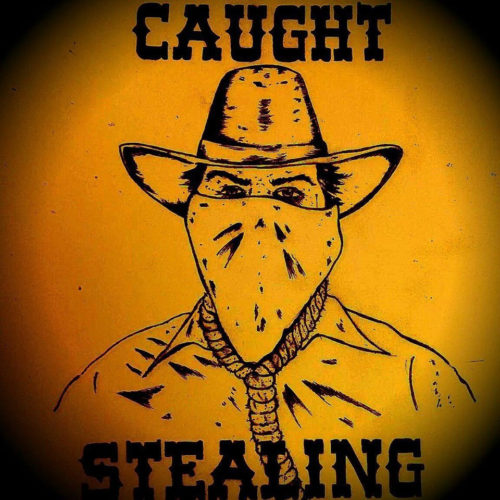
Before the flop, in a late position when everyone folds to you, be sure to glance at the players to your left, looking for tells. If no one is gathering a bunch of chips, preparing to raise, then your raise may win the blinds. It’s best to attempt this steal with a reasonable hand, in case the Big Blind decides to call. Even so, you gain a positional advantage. Unless he has a strong hand, he is bound to respect your raise and check to you on the flop. Then, you can decide whether to make a continuation-bet (c-bet) – and take the pot if he folds.
Stealing the pot on the flop depends on the community cards placed on the board. Whenever the flop brings only unsuited medium and small cards (no honor cards; i.e., A-A down to 10-10) or a small pair with a small/medium third card, chances are that the flop missed your opponents. If they all check to you, then your “steal-bet” – using the Esther Bluff – is almost certain to force them out; you win the pot. For more information on the Esther Bluff, I invite you to check out my books (see below).
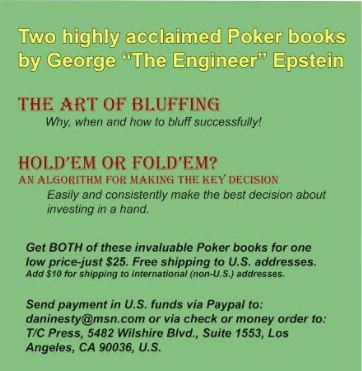
Let’s say you’re playing on one of the legal poker sites for New Jersey players. The flop includes a pair of honor cards plus a small card; and you are in a late position with few (if any) deceptive opponents. They have no idea what cards you have in the hole. The odds are heavily in your favor that an opponent does not have a hole-card matching the pair on the board; so your attempt to steal is favorable.
Holding a monster, your goal is to build a big pot. From an early/middle position, start by checking – rather than betting. An opponent behind you makes the bet; several others call. Now you raise it up. Most likely they will all call your raise; and the pot grows…
Supposing you have earned a tight image, had you bet out rather than checked, most opponents would have folded. You can’t build a big pot in a limit game, if only one or two opponents pay to see the next card.
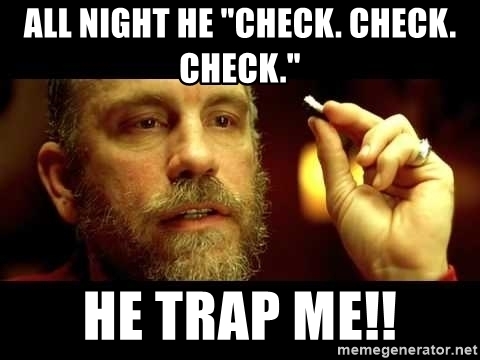
These are three more tactics for building the pot when you expect to win it with your monster hand. Instead of forcing out your opponent:
An aggressive opponent may even elect to try to bluff you out, all to the good…
(Ed. note: Plus, if you’re playing in a brick and mortar poker room, their reaction can be priceless once they realized they’ve been duped. 🙂 )
My poker buddies accused me of sandbagging, but I couldn’t let that bother me. I had to prepare for the approaching storm
— Grown-Up Baby (@Prof_Hinkley) January 4, 2015
Holding a monster hand, slow-playing, and sandbagging tactics serve the same purpose. If your opponents check to you, just check along. An opponent bets or raises, just call. Show no aggressiveness. Unaware of the strength of your hand, he is prone to bet or raise, or even try to bluff you out. Just call. Meanwhile, take care not to offer any tells that could be cause for suspicion. Slow-play to trap your opponents in the hand – and build your pot. Sandbagging is similar; but you are planning to check-raise.
UPDATE: Poker Fighter has just released their new mobile app! More information on this towards the end of the review. 
Every poker player has to start somewhere, but with the dizzying depth of strategy involved in modern-day poker, it can be hard to know just exactly where. Training videos are often overwhelming, with too much happening too quickly for it to be of any use to new players. Really, what the new poker player needs is the lessons that can only come from guided, coached, experience. With Poker-Fighter poker training, that’s exactly what they will get.
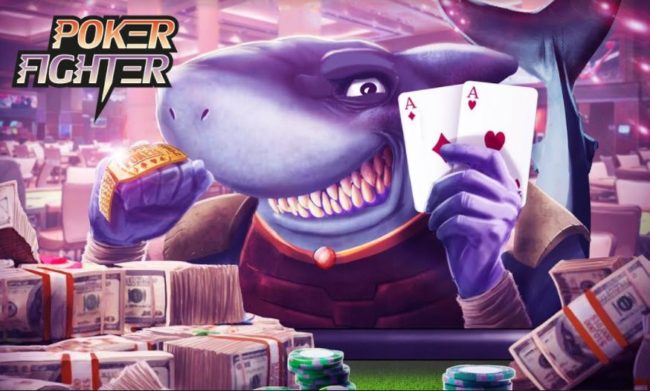

Despite having logged tons of hours at the tables myself, the fact that I still suck at basic poker concepts made Poker-Fighter intriguing to me. I’m a former subscriber to many training sites, so I know their limitations. Too often, I find myself learning about some interesting tidbit of poker theory during study, only to then be too scared to pull the trigger when the same situation comes up in my own play.
The result is that I know a lot of stuff but can’t execute much of any of it. One of Poker-Fighter’s great strengths is that it eliminates this problem by placing you in a risk-free simulation of actual gameplay.
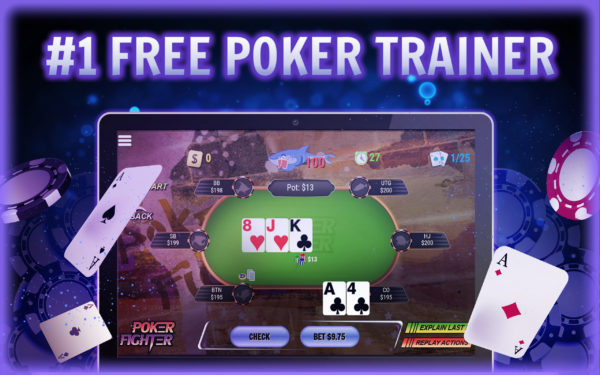

It’s important to note that both words here are important: the “risk-free” part gives you the leeway to allow yourself to make mistakes, while the “gameplay” gives you tangible scenarios that you can practice. That’s why I love the fact that the design of the cards, tables, and chips are done in such a way that you feel like you are sitting at an actual online poker table.
Simulating the visual environment that players will find themselves in (at least in the online version of the game) will go a long way towards making new players feel comfortable with the look and feel of a real-money poker game before they ever have to risk a cent.
It’s a common misconception that “practice makes perfect”. In fact, PERFECT practice makes perfect.
Having a risk-free simulation means nothing if it just serves as a forum for players to ingrain bad habits as they repeat the same mistakes over and over again. Poker-Fighter takes care of this problem with a surprisingly deep and complex web of strategy guides for the beginning player.
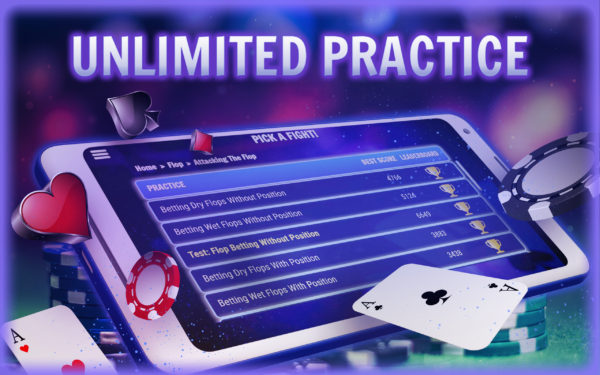

While the content is robust, the layout and presentation make sure that it is also easily digestible. For example, pre-flop strategy begins with the very first decision of any hand – whether or not to play the cards dealt to you. From there, we get a wealth of clearly laid out, progressively developed poker theory. Some of the themes touched upon include positional awareness, how to attack flops, and even re-raised pots on the Turn.
At every stage of the process, you are able to receive detailed feedback about what the correct decision to make is, and why. By simply requesting an explanation of the move, you can get a pop-up that will tell you everything you need to know. Having this information available to you immediately following a decision creates a great positive feedback loop.
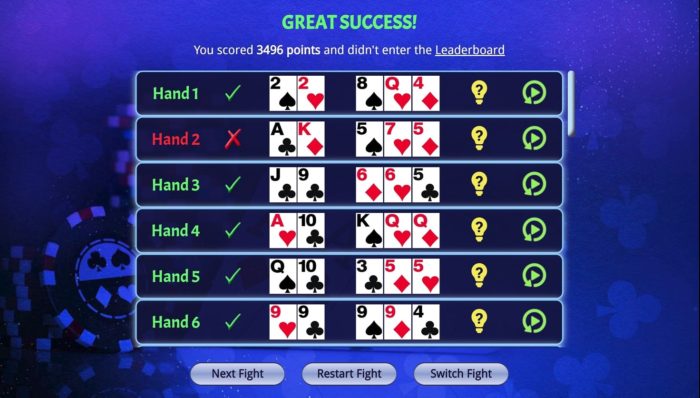

While novice poker players who want to improve their game tend to have very intensive study habits, they are still looking to have fun. Learning any new skill is a challenge, so if the education method is not engaging it will be a long, difficult, slog even for the most dedicated students. This is where Poker-Fighter has other training programs trumped in spades (pun intended), with great graphics and gameplay that will make you forget that you are actually learning anything at all (the best kind of learning!).
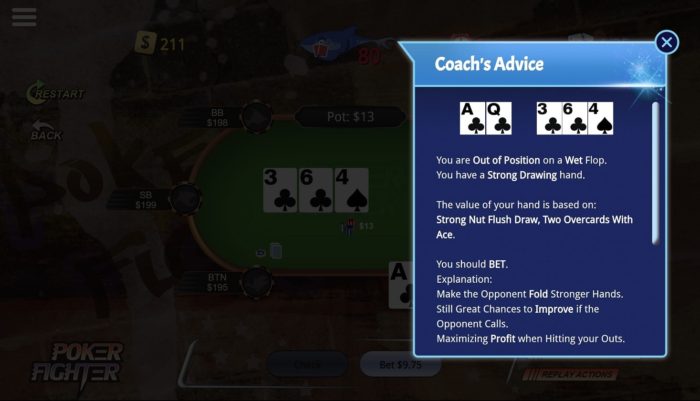

Even better, there is a leaderboard and “Hall of Fame” that turns the learning you are doing into something that will also get your competitive juices flowing. Not only is this a ton of fun, but it has the added benefit of being a great way to put a little pressure on you when making you poker decisions, even though you aren’t risking any money in the moment.


Poker-Fighter has just announced that their training software is now available in the form of a mobile app. Since you’re not always in front of your PC or laptop, having Poker-Fighter at your fingertips via a mobile device means that you can now practice and improve at poker while you’re on the go!
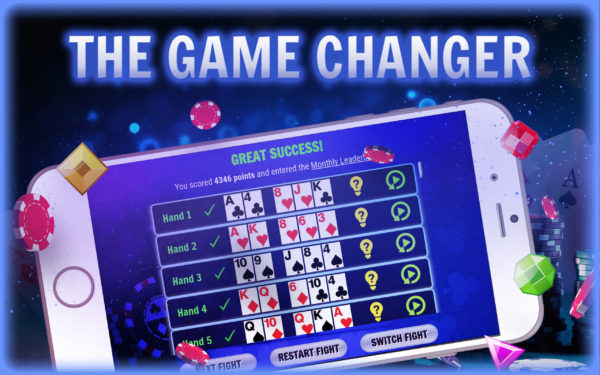

The web version of Poker-Fighter was first released in 2017 towards the end of the summer. The team behind the product have since also released some great updates and upgrades, including:
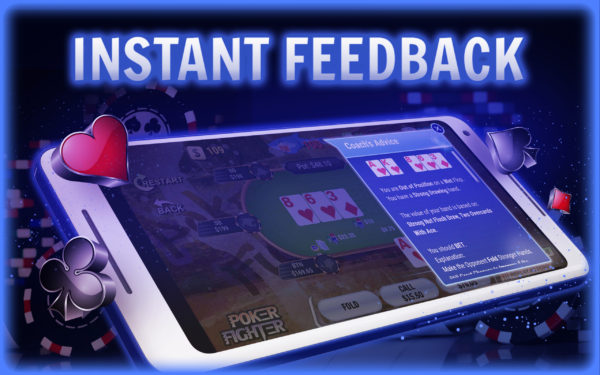

* NEW TEAM PROS: The Poker-Fighter developers have brought on WSOP bracelet winner Shai Zurr and professional poker player Eyal Casias as ambassadors to join their pro team. Zurr and Casias have spend a great deal of time advising the developers on hand ranges and other high-level poker concepts, so you can rest assured that the feedback you’re receiving from Poker-Fighter is truly top-notch!


While using Poker-Fighter, I couldn’t help but marvel at how far poker has come. When I was starting out as a player, all you could really do was hop online, watch a few training videos, and try to figure it out without loosing too much money. The ability to be interactive with your poker knowledge from day one as a starting player is something that should not be taken for granted.


While it’s true that there is a certain limitation to the lessons learned – they are designed to teach basic, ABC poker – that slightly limit the value to intermediate or advanced players, Poker-Fighter fulfills its mission of making poker theory easily accessible to anyone looking to learn.
Overall, it’s a great concept that will make studying poker easier, more effective, and more fun for a new generation of poker players.
The advent of satellites has been a huge boon to tournament poker. Through them, recreational players have a shot at playing bigger buy-in tournaments and grinders have even more events to play than ever before. Moreover, those recreational players get some experience playing with strong players, so they’ll have a better shot at making some money if they do win a seat into the big show. I love satellites myself, mostly because players make so many expensive mistakes in them.
There are two really big mistakes that I see from recreational players in satellites. In fact, I see these from working pros too!


Most recreational players are used to doing things a certain way. Whether it is correct or not, they have a preferred way of playing in a poker tournament, and they often carry that style into a satellite, which can be a huge mistake. The key in satellites is to preserve chips, stay alive, and chip up as safely as possible. In the very early stages of a satellite, it can be correct to splash around a tiny bit to try to chip up, but in later stages that attitude becomes terribly expensive.
Have you ever considered folding aces preflop? Not only have I considered it, I have done it on more than one occasion in a satellite and I am sure that it was the correct play. Let me explain why.
No matter the hustle .. remember survival is the name of the game???
— T-Roc??? (@T_General10) February 13, 2018
Let’s say that you started with 100 people in a satellite that pays 1 in 10. The buy-in was $100 and the top 10 finishers win a seat to a $1,000 WSOP event. There are 11 players left and you have the second biggest stack with 80,000 chips. The player on your right has the biggest stack with 82,000 chips. There are two players below 5,000 chips and the blinds are 2,000/4,000 with a 500 ante.
The first thing we notice here is that one of the two short stacks is almost certain to get eliminated within the next 10 hands. If you get up from your seat and walk away, you are guaranteed a seat. You have already won the maximum prize… unless you screw it up.
Now you are on the big blind, and everyone folds to the small blind, the stack that is slightly larger than yours. Everyone is scared to play a hand, so this would not be uncommon. But what happens next certainly seems odd. He shoves all-in for 82,000 chips.
It gets even weirder when you look down at two aces. What are you going to do now? Can you fold two aces in this spot? This is the best hand in poker! If you call and he also has two aces, you are only going to lose when he makes a four flush, which will be very rare. If he has the best possible hand against you, 67 suited, you are still a three to one favorite. And he will usually be in worse shape than that. Think of all the chips you could have!
But we don’t play tournament poker for chips do we? We play it for money. And chips don’t always equal money. In fact they never do, and in this specific case the difference between chips and money is huge. If you could buy an extra two million chips for $20, should you do it? How much more likely would it be that you are going to get a seat (again, a seat being the top prize in this tournament)? Save your $20; your seat is already locked up… unless you call with those two aces.
If you fold, we know that you are going to get a seat every time, so your equity is $1,000. But what if you call? If we assume that you are a four to one favorite, then the math looks something like this:
Your total equity is now $800+0, so you would lose $200 in equity by getting all-in preflop with the best hand in poker. Now we can compare that to your chip equity where you double up 80% of the time and go broke only 20%. Your stack increases by an average of 80% or 64,000 chips. So you make a play that on average increases your stack by 64,000, but also decreases your equity by $200. Welcome to the world of tournament poker.
This is a situation that we often see in regular (i.e., non-satellite) tournaments, too, but there is not usually such a drastic difference. If the above was news to you, some education on tournament theory will be a big help. I can recommend RedChipPoker.com, LearnWPT.com, or David Sklansky’s book Tournament Poker for Advanced Players. There are many articles online about it as well; simply Google “poker tournament theory.”
Being able to roughly calculate the equity of a play in real money instead of tournament chips is important to the success of a tournament player. This is even more important in a satellite. Rather than cruising along in your standard tournament mode, you must change your thinking. Try getting used to asking yourself the following question:
“How often will I get a seat with each of my options here?”
You should be asking yourself this question quite often as you reach the later stages of the satellite. There is money to be made playing satellites, and answering this question correctly will help you claim more of it.
The second huge mistake I see doesn’t happen at the table; it happens at the cashier window. Many players have the idea that if they can afford the buy-in to the satellite, they should play it. But when we talk about variance in tournaments, and what size bankroll is necessary, we assume that you will cash around 15% of the time. If you first must play a satellite, win it, and then cash in the tournament itself, that percentage goes way down.


Let’s assume that you are playing tournaments with a reasonably small field, and you don’t have to protect your bankroll too much because you also have a job. If you have a good enough job, or just don’t need to worry about maintaining a bankroll just for poker, then play whatever you can afford. But if you are trying to build a poker bankroll and don’t want to rebuild it from your paychecks, then you should be following reasonable bankroll management practices. With small fields, a good player can probably get away with playing anything where he has 50 buy-ins for that event. I don’t have a job, and really don’t want to get one, so I stick with 100 buy-ins.
This means that if you are going to play a $1,000 buy-in tournament, you should have $50,000 in your poker bankroll if you are going to be serious about bankroll management. But this does not apply to satellites because the variance of the satellite and the tournament together is much higher than just playing a tournament.
If we assume that you are a very good satellite player, playing a 1 in 10 satellite, you should get a seat about 15% of the time. This is a nice profit for you. But if you are playing the tournament as well, and assuming you are a very good player, you will cash about 20% of the time. Now, instead of putting money back into your bankroll 20% of the time, you are going to walk away with something .15 * .20 = .03 or about 3% of the time. This drastically increases your variance.
You should generally only play satellites into tournaments that you would play even if you didn’t win your way in. The satellite is a way to save or make money, not a way to “take a shot” at a bigger event that you wouldn’t normally play. I know, it takes the fun out of it doesn’t it? If you are just playing for fun, then don’t worry about a bankroll and just have fun. But if your bankroll matters to you, don’t decimate it by playing satellites into events that you can’t afford to play otherwise.
You can still play satellites into events you can’t afford, but you must do something to cut down that variance. You can do this by:
My favorite thing about satellites is probably your favorite thing, too. They give recreational players a chance to play big events that they usually wouldn’t be able to afford. This spares me the pain of being at a table full of silent grinders with headphones and book bags. All hail the satellite, Saver of the Day, Bringer of Recreational Players, Low Variance Cash Cow, and The Great Creator of the Moneymaker Effect!
Playing from the blinds is probably one of the hardest things in poker. You’re forced to put money in, you’re always out of the position, and, on average, you’ll have a rather weak hand. All of this combined makes blind play a rather difficult matter.
However, since there is no way around this if you want to play Texas Hold’em (we all have to post blinds, after all), learning strategies and techniques to minimize our losses is essential to our poker success. That’s why I found the Printing Money from the BB Post-Flop course by MyPokerCoaching rather intriguing and decided to give see what it was all about.
The course consists of two parts, with both parts focused on playing from the big blind (as the name suggests). The first part deals with pots where the original raiser (button) doesn’t c-bet, while the second part deals with situations where we’re facing a c-bet. This is a natural and intuitive way to split the topic, so it certainly gave me the confidence that the course on the whole could be really useful.
Before moving on to the course’s title topic, the first video first tackles the big blind problem at large. A good point the instructor makes is that playing from the big blind is always going to be a losing proposition, so that’s something to come to terms with. This is a good distinction to make, especially for less experienced players, who might be feeling bad about losing from the blinds.
As stated, while no one wins from the blinds, our goal should be to minimize the loss, which would naturally be one big blind every time it is our turn to post. Reducing this amount even by 10% or 20% should already be considered a success. So, again, have reasonable expectations here: your goal is simply to reduce losses as much as possible.
This introductory part then goes on to deal with some general considerations about big blind play, such as the fact that button opens are usually fairly wide and that we need to defend around 67% of the time to make it unprofitable for them to raise every time we are in the big blind. I must admit being quite surprised to discover that the percentage was that high. That, too, is definitely something to keep in mind, as it is probably fair to say it doesn’t come naturally to too many players.


Although I found it a bit strange that the first part was going to deal with the missed c-bets, truthfully speaking, the order of the topics isn’t that relevant as long as all important information is covered. This part of the course is introduced by emphasizing that if we’re going to defend wide from the big blind, it only makes sense if we’re going to continue fairly wide after the flop.
The instructor then proceeds to explain that we have ample reasons to attack missed c-bets because, as a general rule, people c-bet too much. This means that, in most cases, a skipped continuation bet indicates weakness.
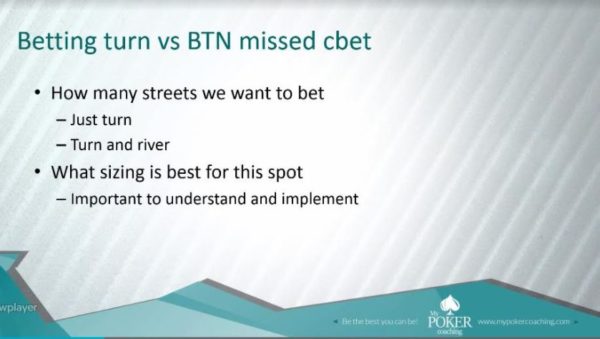

However, since we’re still out of the position and are playing against a generally stronger range, attacking missed c-bets takes some planning. There are couple of things to consider when deciding on how to proceed on the turn:
It is essential to keep these things in mind when planning your turn play against a missed c-bet. The instructor then goes on to give several examples of different boards and various turn and river cards, explaining the reasoning behind correct decisions based on these considerations.
The examples provided are really detailed and well-explained and it’s suggested (both by the instructor and by me!) that you take the time to analyze them on your own. The topic is certainly covered well and it opens a lot of ideas to think about when planning for your play from the big blind.
The second part of the course deals with probably more frequent situations, which is when we are facing a c-bet when defending from the big blind. This part also begins with some general considerations, discussing the fact we need to defend wide and continue wide, but how far should we go when our opponent has shown the interest in the pot?
An important thing emphasized right at the start is that playing fit-or-fold poker will not work. If we give up every time we miss, we’ll be giving our opponents too much of an edge. Secondly, as already mentioned, people tend to c-bet too much, which is something we need to be taking advantage of.
A part of the video that I found really helpful is the one explaining the math behind a check-raise and how, with proper bet sizing, you only need your opponents to fold just 51% of the time to make it work – even without accounting for the times when you do have a good hand or catch up on the turn and the river.
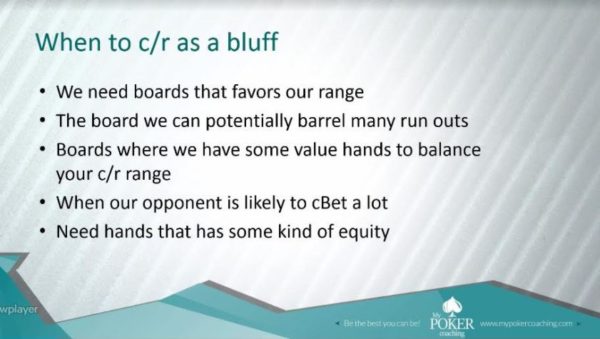

After these considerations, the video proceeds to explain things to consider when deciding whether to check-raise a continuation bet, explaining the reasoning behind it. It defines good hands to do it with, such as:
Like in the first part, there are several examples explaining these various concepts, explaining how and why they work. These examples consider our holdings, board texture, opponent’s perceived range, etc.
In total, MyPoker Coaching’s Printing Money from the Big Blind Post-Flop course lasts about 90 minutes and it offers some invaluable insights into the big blind play and various ways to reduce your losses when in the blinds. It gives some very solid advice based on the numbers and calculations, but it also considers some general trends and tendencies in the game that you can take advantage of.
For anyone looking to improve this segment of their play, this course is well worth the money and the time, but you’ll be have to be ready to do some “homework” assigned by the author. If you follow the instructions from the video and do the work, however, you’re guaranteed to see some significant improvements in this area of your play.
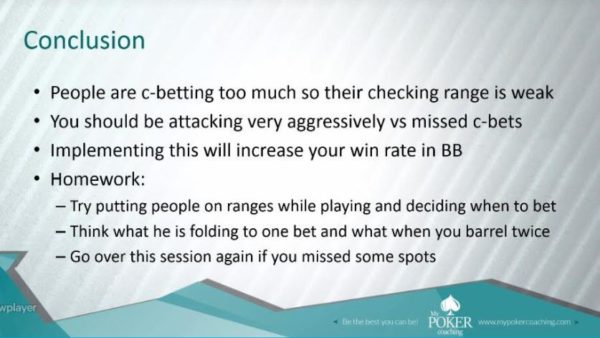

In my previous column here on Cardplayer Lifestyle, we explained why bluffing is essential to winning at poker, and presented an overview of key skills for successful bluffing, including the Esther Bluff tactic. This column goes into somewhat more detail.
In all varieties of Texas Hold’em, position is important to success in all forms of deception, including bluffing.
Examples:
From a middle/late position, preflop, if there is no raise before you, a bluff-raise may help you steal the blinds. If a limper does call, you likely will have gained the “virtual button” position, giving you a distinct edge.
On the other hand, some situations shout “Red Light!” For example, from a late position, usually it is best not to bluff after a bet by a tight player. Likewise, you usually shouldn’t consider bluffing after an opponent raises, as you are likely to be called. Exception: You hold a small pair or better; all the other opponents folded to his raise; and you know that he is a deceptive player – likely to be trying to bluff out his opponents. In that case, reraise as a semi-bluff. Even if he calls your bet, and you miss, your small pair may still be best…
Just like nobody visits an online casino expecting to win a huge jackpot, you shouldn’t expect to win all your bluffs. They’ll work often, but not all the time. There will be occasions when a bluffing target catches a strong hand.
What percentage of your bluffs must succeed for bluffing to be a profitable option? Based on limited analysis, if you win more than 40 percent of your bluffs, you are likely to be well ahead. Even in a low-limit game, a “smart bluffer” can win over 70 percent of his or her bluffs and steals. That’s highly profitable!
Image – your opponents’ perception of how you play your hands – can make a big difference. Being highly selective as to starting hands, you are bound to have a tight image. Then, when you make a bluff, your opponents are more likely to believe you and muck their cards, surrendering the pot to you.
Table image is everything.
Playing lots of hands? Play tight for a stretch (with big value bets)
Folding non-stop? Play a few trash hands#pokertips
— TopPokerValue.com (@TopPokerValue) January 21, 2018
Poker players are inclined to favor high-ranking cards (Ace to ten). If the flop includes such a card, you are not likely to bluff out all of your opponents on the flop, so if you’re a relatively inexperienced player, it’s advisable not to try bluff in that case. On the other hand, a “dry flop” generally suggests a good opportunity to go for a bluff.
Another situation: An Ace falls on the board on the flop; you don’t have one. The betting is checked all around. The turn brings a blank; everyone checks to you. This might be a good opportunity to go for a bluff – using the Esther Bluff, of course.
As I say in my book, The Art of Bluffing, “Every winning player should have the semi-bluff strategy as part of his poker ‘arsenal’ and employ it when appropriate.”



In the third and final part of this series, we will focus on the other forms of deception, namely slow-playing, check-raising, trapping, and baiting your opponents.
Before diving in to my review of “The One Percent” video series, let me first start by introducing you to its creator, James “Splitsuit” Sweeney. He has been a poker coach full time since Black Friday. He is also an author of well-regarded books, such as Unfolding Poker, he writes poker strategy articles, offers webinars, YouTube videos, and a podcast. He is someone who I consider to be one of the greatest poker geniuses of our time, pumping out incredible amounts of the highest-quality poker strategy content on a regular basis. He really is a poker genius!


Image credit: Redchippoker.com
Sweeney’s The One Percent video series has by far been the meatiest material I have reviewed to date. You really truly get what you pay for, my friends. The cost of course – $199 for the Basic edition and $399 for PURE edition – will without a doubt pay for itself! Sure, there is free poker content all across the internet, but the real goods are not given away.
Just put the finishing touches on the The One Percent #poker course. It’s not even released yet and I feel like the price is too low lol
— SplitSuit (@SplitSuit) November 3, 2017
Not only do you get four weeks’ worth of videos, you get three homework assignments! Homework not sound fun? If you are the kind of guy or gal that peruses fine poker blogs – such as Cardplayer Lifestyle 🙂 – then I imagine you are the kind of player that wants to take your poker to the next level. So yes, poker homework is our idea of fun on a Friday night!
We don’t just hop over to a table and play our hole cards with just their face value in mind. We consider a villain’s range in each position, what the villain is thinking about our range in our position, what the villain thinks we think about his range, and so on and so forth.
While the fishy regs are out clubbing, we are plugging away at the numbers off the table getting ready to set our hooks! We real poker players aren’t just fans of the game; we study the living day lights out of it. We eat, breath, and sleep poker. So, if you’re the kind of poker player who takes the game serious and wants to improve, keep on reading.
The videos you receive during the course are meant to be weekly installments that are supplemented by a weekly email instructions. Sweeney encourages people to email him with questions and he responds back quickly. I was so impressed by that! A spreadsheet template is included in the course for working on some of the exercises.
It was easy to figure out, but I emailed him a question about some of the formulas in the spreadsheet to know more about how they worked for my own curiosity and James emailed me back almost within the hour! I think this is something that really separates Sweeney’s from other poker courses out there.
The entire One Percent video series focuses on frequencies. I will be completely honest: prior to taking the course, I had only heard of frequencies, I didn’t actually know what they were exactly. All I knew was that frequencies were related to players tendencies. I didn’t know what a correct or incorrect frequency was. But I did know how to take advantage of certain player’s tendencies, like C-betting more into players that are fit-or-fold on the flop, and floating to a players C-bet if they only double barrel when they flop the nuts so you can steal it away from them on the turn.


Other than that, I couldn’t fully appreciate the value of knowing about frequencies in depth. I have read a ton of free poker training content and none of it that I had come across went into frequencies. It’s not only important to know when someone else has frequency issues that can be taken advantage of, but it’s also important to know if we have frequency issues that others can exploit. So, don’t be the player that doesn’t know! Dig into The One Percent video series and be the player who owns and dominates the table.
The course starts by laying down the foundation of the entire 1% system, which is covered primarily by two main principles that are threaded throughout the whole course. If someone was to implement just these two rules and what is called “the 70% model” alone they would see instant results in their game.
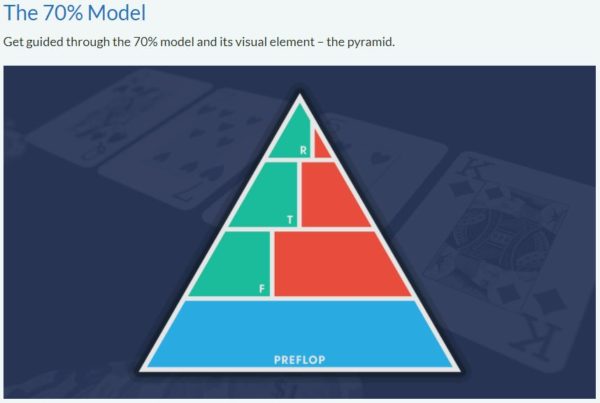

After illustrating how the two rules and the 70% model work, Sweeney goes onto explain how common poker applications – such as 3-betting, bluffing and value betting, C-betting, and double barreling – are applied. He then exposes common errors and talks about what he refers to as the good/bad/nonevent concept, which further illustrates how to employ the 1% method.
Sweeney wraps up the course by digging into the nitty gritty business of refining your hand selection, what to do if you get raised, how you should be raising, and encouraging you to complete an exploration of one of your own hands using the spreadsheet provided.
He follows up with an email pointing you in the direction of what to do next, which is very helpful because at that point you will have arrived at a whole other level. Specifically, you will need to know how to progress from there. Perhaps you’ll find that there is nowhere else to go other than to quit your job and become a professional poker player! After all, you’ll certainly be equipped for it!
I would recommend The One Percent video series all day long. Even if you are an online regular or play semi-pro, this course can and will improve your game without a doubt. It is not an accident that James Sweeney has been coaching for over 10 years. He has that amazing gift of not only knowing the ins and outs of poker theory, but he can also explain it in easy-to-understand language that anyone, from a novice to a seasoned professional, will understand.
Admittedly, this material might have been too daunting for me to learn had it not been for Sweeney’s ability to break it down into easy-to-digest chucks that I could take in and grasp. The best part? I’ve found the course to be instantly applicable. I was able to apply the concepts I had learned and see the positive results right away. My bankroll thanks you, James!
I am a much harder opponent to play against now, which is exactly what any poker player wants. We want to be the 1%!
In my never-ending quest to improve at playing poker, I’m always on the lookout for new, excellent poker courses and training products. A friend recommended that I check out PokerNerve MTT Training if I wanted to improve my multi-table tournament (MTT) game, so I decided to see what it was all about. I’ll be honest and admit that I’d never visited the site before, despite it having launched back in 2012. With that said, since the course offered a free 7-day trial, I took advantage of it to get a taste.
I liked it enough to get the “Road to Success” Premium package, which offers more than 90 lessons and supplements. For those who don’t have the bankroll to splurge, PokerNerve also offers a payment plan (three payments of $249) or a “Basic Package” for $139. The latter is a scaled back version of the course with just 20 lessons and supplements.
You’ll be taught by Kelvin “Acesup” Beattie, who has amassed more than $4 million playing online over 14 years. During that time, he has also won 10 triple crowns. Not surprisingly, he was at one time the No. 1 ranked online poker player in all of Australia according to PokerStake.
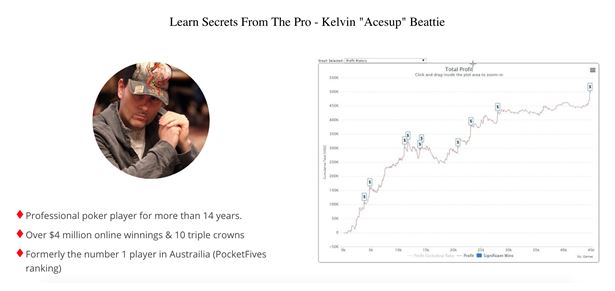

Before going any further, let me be clear – I am not an online player. I’m based in the United States and I won’t play on unregulated sites. As such, the only opportunity I have to play poker online is when I’m in Las Vegas for the WSOP each summer. Even so, I find that a lot of online MTT strategy can be tailored to fit live play. At the very least, it helps me understand online players better when I encounter them across the table in live tournaments, like World Series of Poker events.
Also, note that the MTT Training course must be accessed via a web browser, as there’s currently no mobile app for PokerNerve. That said, the functionality of the site is solid, due in no small part to its simplicity.
Here’s a look at what you get from PokerNerve’s MTT Training course:
The videos average 40 minutes in length, so getting the most from the course is certainly a time commitment. It’s worth noting, however, that they’re not frivolous videos. By that, I mean that you don’t have to watch tons of footage before getting a tidbit of wisdom. Instead, Beattie gets to the point quickly. The videos are focused and reliable.
As for the lesson plan, it’s laid out in a linear path. You simply start with Module 1, Lesson 1, and work your way through in sequential order. As many training sites I’ve tried lack organization, the simplicity of that sequential order can’t be understated.
PokerNerve’s MTT Training course is comprised of six Modules, with two each devoted to basic lessons, intermediate lessons, and more advanced strategies.
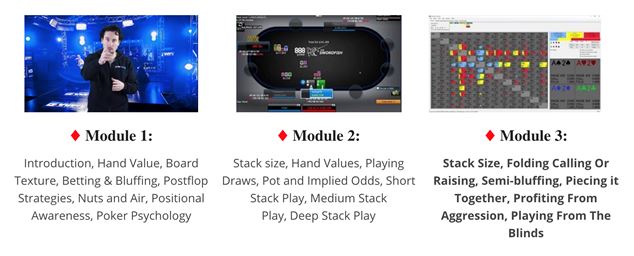

Module 1 includes a basic introduction, ranging from topics like hand values to board texture to post-flop strategies to positional awareness. Module 2 then moves into stack sizes, implied odds, and play based on your stack size (short, medium, and deep). If you’re an experienced tournament player, you’re likely familiar with most of this information. Still, it never hurts to review the basics.
Module 3 kicks things up a notch by introducing semi-bluffing, playing from the blinds, and profiting from aggression. Module 4 piggybacks off this by discussing bluffing, hand planning, bet sizing, and isolating. It’s also here that you’ll learn about using a heads-up display (HUD), which, as mentioned above, wasn’t really applicable to me. That said, it was nice to get a sense of what sort of tools are available to online poker players.
In the advanced strategies portion of the course, Module 5 takes a look at the different stages of a tournament, from the early levels and then progressing on through final table and heads-up play. You’ll also learn about bubble play and the Independent Chip Model (ICM). For me, mastery of the information presented here is really what separates serious players from recreational ones.
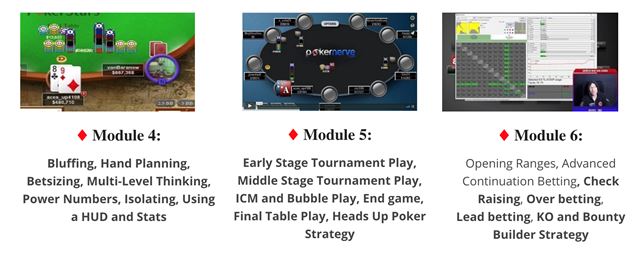

To give you a personal example, I recently played a $200 buy-in tournament at my local casino. Six players remained but only five would get paid. I had a meager 5bb stack, but, amazingly, two other players had stacks of just 2bb. The blinds were going to hit them before me, so – long story short – I ended up folding Big Slick to a raise. They thought I was crazy, and then I mentioned there were too many ICM implications.
“What’s ICM?” a lady at the table asked.
“It means making it into the money,” another player responded. Neither had a clue, and I wasn’t about to educate them (why should I give away the lessons I pay to learn?!). Anyway, there are few things more important late in a poker tournament than understanding ICM, so if you don’t, find a way to learn. As mentioned, PokerNerve’s MTT Poker Training course can teach you.
Back to Module 6, it’s here that concepts like advanced opening ranges, continuation betting and over betting are examined. This is the dessert after digesting the meal. If you’re good, the lessons here will make you really good.
I thoroughly enjoyed working my way through PokerNerve’s MTT Poker Training course and came away feeling I got my money’s worth. But don’t just take my word for it; take it from the UK’s Jack Sinclair, who was one of 2017’s hottest players.


He’s best known for finishing eighth in the 2017 World Series of Poker Main Event for $1.2 million. A month later he took down the partypoker German Poker Championships €25,000 Super High Roller for $294,735.
“I wouldn’t be where I am today without the Road to Success,” said Sinclair, who saw a 100,000% return on his initial $690 investment for the course. “Two years ago, I was struggling to beat the low stakes. Getting on the Road to Success was the best decision I ever made. It taught me the skills I needed, not just to beat the low stakes, but to go on to crush the mid- and even the highest stakes available.”
If there is one thing that poker players know how to appreciate, that’s putting your money where your mouth is. That’s exactly what Kelvin does in the bonus module, entitled “2 months 50K.” As you could guess from the title, the module features Beattie as he straps in to do some serious grinding and try to reach the $50,000 profit mark within two months.
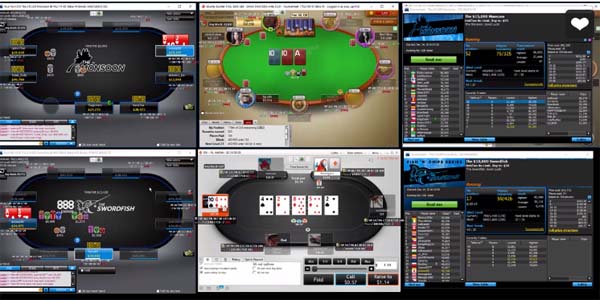

The module contains 14 videos in total with recordings of real-time tournament play. You get to see every step of the journey, which makes these videos not just very educational (as Beattie explains his thought process in all important spots), but also quite entertaining.
So, does he get there in the end? No spoilers in this review. You’ll just have to watch it for yourself to see how this challenge ends.
There are a lot of training sites out there, but few have the intimate and personalized feel of PokerNerve. Perhaps more importantly, they give you the opportunity to experience it for free with the aforementioned 7-day trial, so there’s really nothing to lose and no excuse for not checking them out if you’re serious about improving your game.
I imagine that a lot of Cardplayer Lifestyle readers probably wonder what the difference is between themselves and a world-class poker player. What separates you from Fedor Holz or Phil Ivey? I used to think I was pretty good at basketball, and for a streetball player I was pretty good. Then I got the chance to play with some ex-NBA players and some serious Division I college players. Apparently I am terrible at basketball.
The experience of playing with serious basketball players was eye-opening. They were incredible. I was used to being the best player on the street courts where I played, and I expected them to be better than I was, but it was like being a child playing with grown men. Playing with the best poker players in the world is a similar experience if you show up to the WSOP after being the best player in your home game or at your local card room. But it doesn’t feel the same.
The luck factor is a part of it – much like you never know if you might win big after receiving free spins at a slot machine. But the biggest contributor to amateurs overestimating their own skills is how much information is hidden. When a pro dribbled around me fast as lightning and dunked (again), I could see his advantage. But when you get outplayed by a poker pro, you often have no idea what happened. You can’t see their cards and you don’t know what their thought process was. You don’t what they saw in your eyes, your body language, or your bet sizing. You may have no idea that they just owned you.
So, my goal with this piece is to give you a look into the world of a serious professional poker player. How they think, what they notice, and the way they make their decisions may be completely foreign to you. Learning these things can obviously help your game, but it can also help you gain an understanding of how the pros play and what their thought processes are. At the very least, hopefully reading this will help you avoid getting trapped by them so often if you play in tournaments with world-class players in the future.
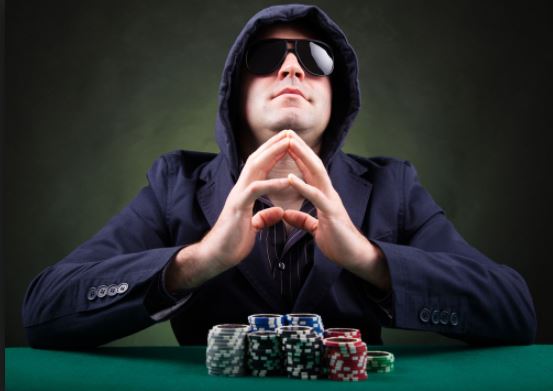

Let’s start with what they see. Every player has a little different skill set, but a good live pro is watching all the time, picking up information that they can use later. If you walk up to the table looking at all the players and their stacks, we notice. If you ask to see someone’s chips, we note that you understand at least something about stack sizes. If someone shows you the winning hand and it still takes you five seconds to throw your cards in the muck, or you feel the need to show them to the table before folding, we remember that you have trouble accepting that your hand is beat and may pay us off in a future hand.
Everything from your clothing to your facial expressions and body language tells us something about you. And it’s unavoidable. You can be less readable, but even that tells us that you have put some work into it and are thinking about covering those things up. If I run into a robot who constantly watches the table and doesn’t speak or move, I know that he is a killer, and I am very careful playing hands with him. But it’s better than being completely readable. I love playing hands with those guys.
A great player doesn’t just glean information about their opponents. They also know how to use it. If I know that you are a thinking and aggressive player, and you three-bet me with 24 big blinds in your stack, I won’t ever go all-in on a four-bet bluff because a player with a serious poker education is almost never going to three-bet fold against me with a stack that short. With 35 big blinds, however, I know they could fold and they may be three-betting light. With a player who appears to be inexperienced or uneducated – a recreational player – I may shove all-in as a semi-bluff in that spot because they may be able to make a bad fold and may overestimate my four-bet shoving range.
Do you know what we are doing when we ask to see your stack? Most recreational players assume that we do that just so we know how much money we are risking or how much we could win if we have the best hand. But it’s much more than that. If you raise my big blind from middle position with a 24 BB stack, I am actually more likely to defend with a hand like 68s than I would if you had 34 big blinds. This is because I have some great moves for my hand against your stack size.
If we assume that you raised to 2.5 big blinds, there will be around 6.5 big blinds in the pot when we see the flop. If I flop a draw, I can check, and when you bet I can move all-in to win a pot of around 10 big blinds right there. If you missed, you fold and I win, which will happen often. But if you call it doesn’t hurt me too badly because you only have another 17 big blinds left in your stack and I have a draw to bust you… unless I see you miss the flop.
One of the most reliable tells in poker is when a recreational player stares through the flop for a few seconds after it falls. They are waiting for it to get better, unwilling to believe that the poker gods have forsaken them yet again. They are angry with this stupid flop. In that case. I can lead out and steal the pot right there if I think they missed and I haven’t flopped a draw myself.
READ MORE: Making a Living as a Tournament Poker Player
What if I flop a monster? With these stack sizes, I have a great weapon for that, too. If I check-call the flop, you will often bet again, and my check-raise all-in on the turn won’t be much more to call. You will have trouble folding with almost 40 big blinds in the pot and only 10 left in your stack if you have any piece of the board. And if you fold I have still won a nice-sized pot and crippled you. If you check behind on the turn, you will often have enough to call a reasonable sized bet on the river. I’m so aggressive that you will expect me to be bluffing the river after your sign of weakness on the turn. And, again, I’ll win a nice pot.
With 34 big blinds in your stack, my moves are different, and tougher to use. You can hurt me worse if I lose the pot, and being out of position could be a problem for me with the awkward stack size. If I have position, things are much easier. With the 24 big blind stack, my weapons are almost too many to list.
Do you know what a resteal is? It’s one of my favorite things to teach to new students because it is so powerful, but most recreational players know nothing about resteals. With a few days work, you can play a 12-20 big blind stack almost perfectly using one of the most powerful tools in tournament poker. Here’s a quick look at the math of a resteal.
If an aggressive player raises from the cutoff seat with a big stack, we use our best guess to estimate their range. Let’s assume that this player is raising 30% of their hands in this spot. If you go all-in with 15 big blinds from the small blind, the big blind will only call around 3-4% of the time, and when they do you get to see all five cards; sometimes you will win. But that 3-4% isn’t too scary.
The original raiser will typically only call with about 7% of their hands even if they know about resteals. If they are a really great player, and they know that you play well enough to be capable of a resteal, then their original raising range might be much tighter, but we are assuming a typical player who won’t be worried about resteals and will just be raising lots of hands because that is what they think you should do with a big stack in late position.
This means that 23 out of 30 times they will fold and the big blind will call about 1 in 30 times. So, 22 out of 30 times your all-in move will be successful and will win a pot with about five big blinds in it. You increase your stack by 33% without seeing a flop most of the time.
And when they do call? Well, you should usually be restealing with a hand that has some equity all-in against the top of their range. A hand like the aforementioned six-eight suited is a good example. Getting all-in with eight high seems maniacal to many inexperienced players, but it’s a great hand in this spot and super profitable. If they call, you will have around 32% equity against their range. So out of every 30 times you make this play:
The actual equity of the play is thus 110+45-82 = 73 big blinds. You make almost 2.5 big blinds per attempt. This is an increase of almost 17% to your stack every time you make this play. In fact, this play is so good that you really can’t beat poker tournaments without it. So, knowing that the other strong players at the table know about this play and may resteal against you or set you up for a resteal can save your tournament life!
Did a resteal shove w/ Q8s from BB. Snap called by Q6o ??? Doubled up. 11/14. top 5 get $. Need to fin top 3 to break even today. #poker
— ₿-Yeezy (@2SlyBry) June 15, 2014
The resteal is just one example of a weapon that a professional poker player has probably used against you. We know what stacks we should resteal with, against what opening ranges, and with which hands. And with deeper stacks our weapons multiply.
My hope is that this article doesn’t intimidate you, but rather that it educates you and gives you a glimpse into how the pros think. I love recreational players. We need them in the game. I was one myself when I started playing and I hope to be one again someday when I retire from competitive poker. But giving recreational players a fighting chance is what I have done for most of my poker career. Even a few lessons makes a big difference, and a training site can make a huge difference for a very small investment. I recommend LearnWPT.com for tournament players and RedChipPoker.com for cash game players as excellent sites with lots of educational content for very little money.
I hope to see you at the tables. Just don’t use the information in this article against me, I’ve got bills to pay.
READ MORE: 7 Factors to Weigh When Looking for Soft Poker Tournament Fields
Gambling is said to be a business older than written history. While there is no way to verify this claim, there’s evidence pointing to the construction of the Great Wall of China being funded at least in part through state-run lotteries – and that happened over 2,000 years ago. Canada’s history of gambling is much shorter yet it still starts before the first European settlers set foot on the land. In short, it’s an odyssey that spans from stick game to online slots; this is Canada’s gambling history.


The 10 Canadian provinces and three territories
Nowadays, we’re of course familiar with famous Canadian poker players, like Daniel Negreanu, Mike McDonald, 2010 WSOP Main Event Champion Jonathan Duhamel, among countless others. It’s quite possible that those players’ respective histories might be quite different if they had not been allowed to gamble in the Great White North. So, perhaps, in order to gain a fuller appreciation of Canada’s poker players and thriving gambling industry of today, it pays to look at the country’s long history of association with gambling.
READ MORE: 5 Surprising Ways in which the WSOP is Just Like Canada
Before the first Europeans brought their games to Canada, the native tribes used to engage in stick gambling, and it was a lot different from the fast-paced way we gamble today. These games could last for days at a time, as they played for stakes such as gunpowder and tobacco, among others. These traditional forms of gambling have been preserved as a cultural heritage to this day, with the Yukon Territory First Nations in Canada holding Stick Gambling Tournaments to keep the tradition going.
The next widespread form of gambling in Canada gained its popularity during the Klondike Gold Rush in the late 19th century. By that time, card games, in general, were pretty widespread, thanks to the settlers bringing their cards and games with them to the new land. But “Faro” was perhaps the most popular card game at the time. It was a bit like a mix of blackjack, baccarat, and other similar casino games with a fast pace and considerable payouts. Later, it was unseated by poker.
And BOY do Canadians love their poker. Oh Canada, indeed! Just to illustrate the point, while still way behind the U.S., Canada proudly occupies the runner-up spot on the list of WSOP bracelets won by country.
Anyhow, back to the late 19th century. It was the time when Canada’s first Criminal Code was enacted. Based on the similar legal framework from Britain, it did tolerate some forms of gambling under certain conditions. Later amendments introduced pari-mutuel (pool) betting, certain forms of gambling for charity, and during special events like agricultural festivals. These laws remained mostly unchanged between the 1910s and the 1970s. Then, a new round of amendments gave provinces the right to regulate gambling and license gambling operators. Almost two decades later, the first Canadian casino opened in Winnipeg, followed by another one in Montréal, and many others.


Image credit: maplecash.com
Today, gambling is mostly a state monopoly in Canada, with the provincial lottery and gaming corporations (Crown corporations) being the only ones allowed to “conduct and manage” gambling activities within their borders. They are also the ones that can operate poker rooms and sports betting operations, both online and in real life. Several lotteries – like Loto Quebec, the BCLC, and the OLG – have launched their own online casino and poker services to compete with their offshore counterparts, and perhaps some others will decide to do the same in the near future.
While the interview below from the good folks over at CalvinAyre.com is now a couple years old, it reflects the current state of online gambling in Canada; namely that Canadian citizens have nothing to worry about when they choose to ante up online.
BITCOIN!
OK, now that we have your attention, let’s focus a bit more on what this site is about. If you’ve been paying attention to industry news, you know that cryptocurrencies are beginning to gain increased acceptance around the world, including in online poker rooms and casinos.


Image: zazzle.com
There are numerous crypto casinos and crypto poker rooms that have sprouted up that are also beginning to carve their own niche in the industry. Like with anything new in the gambling world, there are things you need to be aware of when considering whether to play at a crypto poker room or online casino.
Below, then, are seven things you need to know prior to signing up at a crypto casino or poker room.
Whether you play at a crypto casino or a crypto poker room, you will see the same style of games you’re accustomed to seeing. You can still play slots, blackjack, roulette, table games, and Texas Hold’em Poker.
The difference is that the selection of games is often going to be much smaller in a crypto poker room or casino than at standard online casinos and poker rooms. You may, for instance, be limited to only Texas Hold’em or Hold’em and a sprinkling of Omaha. Crypto casinos will often have a small selection of games that are specifically designed for crypto, so you often will see games from second- and third-tier providers.
The exception to this rule are standard casinos that also allow you to make deposits and withdrawals in crypto. For instance, you can play your favorite Poker Games at one of the many new UK online casinos and enjoy fantastic promotions and the latest game releases from a healthy bunch of software providers. These are different than straight “crypto casinos” that only allow you to deposit/withdraw and play with cryptocurrencies.
In the future, we will likely see more operators adopt cryptocurrencies as online gaming payment methods and the quality of gaming at crypto sites will naturally improve as a result.
You want to play at a poker room or casino accepting cryptocurrency? Great! Chances are that you can fund your account with Bitcoin… or Bitcoin. If that won’t work for you – you can use Bitcoin. Presently, many places that accept cryptocurrency deposits are only taking Bitcoin.
Bitcoin is the most well known and the one cryptocurrency you can find on every exchange, so it’s logical that it is the primary one accepted for online gaming purposes. This is beginning to change as the popularity of altcoins increases. The main reason this is beginning to change is because of one universal truth about Bitcoin in it’s present form, namely…
If you’re new to Bitcoin, or have never made a physical transaction using Bitcoin, then you’re going to be in for a bit of “sticker shock” when you make your make your first deposit at a crypto poker room.
For example, last month, I made a small deposit to an online casino as a test. I sent .001 Bitcoin (~$13.30) to the casino. The transaction ended up costing me .00226 Bitcoin (~$30.06). Thus, the total transaction hit me for .00326 Bitcoin (~$43.36).
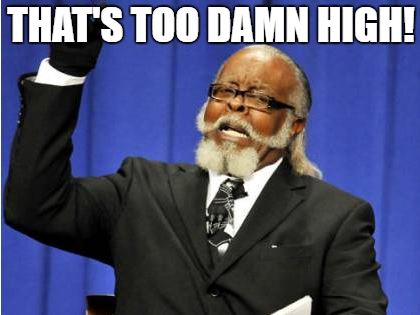

Imagine being someone who makes multiple deposits a month to a crypto poker room. That’s going to get awfully expensive in a hurry. If your crypto casino offers other cryptocurrency options, you’ll save a lot of money. For example, had my casino accepted Litecoin, the fee for the same transaction would have been around $1. Other altcoins charge even lower fees.
The primary advantage to using Bitcoin or other cryptocurrencies to funding your online casino or online poker account is that you usually don’t have to go through any type of verification process with the operator. I say usually because there are a few out there that still require some type of verification for withdrawals, which, for many, defeats the purpose of using crypto to play online poker in the first place.
In standard cases, all you need to do to fund your account is register one, then send Bitcoin (or other crypto) and follow their process to send cryptocurrency to your account. When you’re ready to cash out, you can request a cashout to your crypto wallet using your receive address.
The speed of how quickly your account is funded is often based type of crypto used. In many cases, your funds are available in a few minutes; FAR faster than withdrawals are traditionally processed with fiat currency. With that said, each operator works differently with regard to how they credit your funds. Some will credit after one confirmation, while others may require as many as six. Be sure to read your gaming site’s fine print!
Moreover, cashout speed also often depends on whether an operator utilizes automated or manual processing. Depending on which currency you’re using and whether it’s being done manually or not, processing (and thus, cashouts) could thus take anywhere from a couple of minutes to even days.
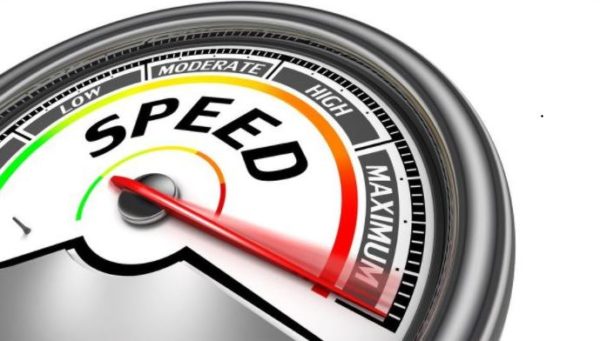

Recently, there have been some issues reported with Bitcoin transaction speed, with some transactions taking days or even weeks. While atypical, it is something to consider. If your site accepts a different cryptocurrency other than Bitcoin, this would be another reason to use it.
One thing you don’t really have to worry about with fiat currency deposits is the money losing value if it just sits in your account. However, with cryptocurrency, the value of each coin or bit of coin in your account fluctuates daily, and pretty wildly at that.
For those new to cryptocurrency, think of the price fluctuations in the same vein as stock price fluctuations. A stock’s value is often different at the middle of the day than at the end, and many fluctuate throughout the day.
With some cryptocurrencies, especially Bitcoin, these fluctuations can be massive. Last month, Bitcoin was worth $19,000 per coin. At the time I’m writing this, it is hovering around the $13,400 mark. It would not be shocking to see it jump to $15,000 tomorrow – or drop to $12,000. In fact, the price may have spiked or crashed during the time it has taken you to read this article! (OK, that’s perhaps an exaggeration, but not by much!)
Obviously, if a crypto’s value drops, it can rebound. Again, Bitcoin is a great example of this. Anyone watching the prices recently has seen it drop to around $13,000 and then go back to $17,000 and then head right back down.
Many cryptocurrencies are presently experiencing booms with many at or near all-time highs. A great example is an altcoin known as Dogecoin. While established as a joke currency, it has a strong following and is one of the most commonly used currencies despite it’s super low value.
Until recently, the coin hovered at around $.006. It shot up to almost $.02. That doesn’t sound like a big deal, but if you had $100 in Doge last month and sold at it’s high, you would have “gotten back” over $300.
One great thing about playing crypto poker is that if you win, your winnings can increase in value, making you a winner twice over.
Contrary to popular belief, crypto is not about to experience an industry-destroying bubble. That’s not to say that there won’t be a major downturn in the crypto economy and that a lot of currencies will fail. That part will happen.
What will likely happen is that we will see the best cryptocurrencies survive and thrive, and the world will enjoy their benefits. So get used to the changes that will occur in the gambling world due to cryptocurrency. It isn’t a short-term fad like bubble insurance, but rather a viable way that online casinos and poker rooms will be doing business for the foreseeable future.
With so many online poker sites available to choose from, it can be difficult to find the one that is best for you. Making this process even more challenging is the abundance of affiliate sites that publish misleading or false information to promote the sites that offer them the highest commissions.
However, if you consider these seven factors, you can find an online poker site that is right for you!
Many poker sites are either restricted from operating within certain countries, or simply choose not to. This is an especially big issue for Americans and many Europeans. For Americans, all online poker is currently illegal with the exception of a handful of sites operating in New Jersey, Nevada, and Delaware (which are only available to players who reside in those states); Pennsylvania is on deck as the fourth state and is expected to have legal, regulated online poker at some point this year. However, a handful of poker sites offer online poker to US players anyway. Players in many European countries are in the same situation. Countries like Belgium, Denmark, France, Greece, Italy, Spain, and others have outlawed online poker unless you play on a site based in those countries, with shared player pooling only very recently coming into play. This allows these countries to both regulate and tax the online poker industry.
If you live in the US or in one of the European countries that restrict gambling on sites not based in that country, then you should probably start by narrowing down your options to sites you can actually play on!
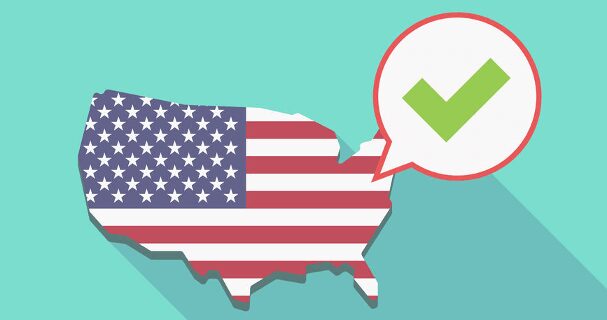

Even players who live outside of these countries will often run into restrictions. We have even found a site that does not accept players from Canada! However, if you reside in a country that typically permits playing online poker, then you should look at this criterion last. That is, find a site that satisfies the other six criteria, and verify that you can play there.
Unless you play poker exclusively on a PC, you also need to look at the various platforms each site supports. Although most sites have software specific to Mac (or at the very least allow you to play within a browser), some do not. There are also a surprising number of sites that do not yet have mobile apps, or only have an app for iOS or Android, but not both. For example, to play poker with Americas Cardroom on a mobile device, your only option is to play within your browser, and they currently only offer Jackpot cash games.
Another major consideration when choosing an online poker site is the site’s traffic. PokerStars is by far the biggest online poker site, with more active players than their next five biggest competitors combined! However, before you run off to start your PokerStars download, there are other factors to consider, both with regards to poker site traffic and to your overall selection.
Even the world’s largest poker site has lulls in traffic at different hours of the day. Granted, even when PokerStars has its fewest players online, it still has more active players than their next biggest competitor has during peak hours! However, for all other poker sites (and for specific games on PokerStars), the time of day that you play will have significant impact on your ability to find enough tables with games running. In some cases, normally active online poker sites with thousands of players during peak hours become ghost towns at other times of day. Sites based in the Americas tend to appeal to players in the Americas. European-based poker sites typically target the European market. There is also a big surge in Asian poker sites, which of course appeal to the Asian poker markets.
That said, a site that is targeting your time zone might not be the best fit for you. Most poker sites get their peak traffic in the evenings, from roughly 6pm to midnight, and experience their lowest traffic from 3am to noon. If you typically play in the evenings, then a locally-based site is probably your best option (traffic-wise). However, if you are a night owl or a morning person, then you may find that a site based elsewhere is a better fit for your schedule.
You might decide to join PokerStars because they have the highest number of active players. However, this does not mean they have the most active players in every game. For instance, PokerStars usually has a single full-table game of 1¢/2¢ PLO8 and that’s it. You might assume that if PokerStars can’t get this game going at higher stakes, then surely nobody can, but that assumption would be wrong. 888poker regularly has games of PLO8 running for stakes ranging from 1¢/2¢ to 25¢/50¢. Likewise, you’re unlikely to see any tables with more than three players for 6-handed No Limit Hold’em above $5/$10 on PokerStars, but you can regularly find active 6-max NLH tables up to $25/$50 on 888poker and €25/€50 on the Microgaming Poker Network (MPN).
Let’s say you play a much more popular game, like 6-max 5¢/¢10 No Limit Hold’em. Of course, PokerStars has the most traffic (at the time of writing this article, they had 64 active tables). However, are you planning to play 64 tables at once? If so, then I would suggest you check out these poker multi-tabling tips! Obviously it’s nice to have more active tables than you plan to play simultaneously so that you can be guaranteed any empty seats will fill, and you have the opportunity to leave a tough table to join a softer one. However, beyond a certain amount there is no additional benefit. For more popular games and stakes, there are plenty of other sites with enough traffic to fill more tables than you’re planning to play (and most of whom crush PokerStars in the other criteria in this article)!
Most poker players want to play the biggest possible tournaments they can find. This is because far too many poker players are chasing the impossible dream. For every Chris Moneymaker (who turned a $86 satellite into a win in the 2003 WSOP Main Event for $2.5 million), there are literally tens of thousands of players each year who lose hundreds of dollars trying to replicate this feat!
READ MORE: Interview with Chris Moneymaker
As I write this article, PokerStars is running its Winter Series tournaments. The first event in this series cost just $109 to enter, and the winner received a whopping $148,542.72. That’s a nice 13,646% return on investment! However, there were 11,392 players in this tournament, which means that if you are an average player, your chances of winning were 1 in 11,392 (0.009%). Massive tournaments like this are brutal for your bankroll. A winning poker player could potentially play the Sunday Million every week for 20 years and not show profit! That’s not an exaggeration either, I mathematically proved it! You couldn’t even call it unlucky either – we ran 200 simulations using 20% in the money and an expected 24% ROI. 91 of the 200 simulations resulted in an overall loss! The worst-case simulation lost over $115,000 (an ROI of -44%). The bigger the tournament, the bigger your variance. In other words, you are far more likely to get results far removed from your expected rate of return (such as -44% ROI after 1,000 tournaments when your expected ROI is +24%).
This is one reason I prefer to play tournaments on medium-sized poker sites. One of the best online poker tournament players I know went five months without showing profit at the start of 2012, playing tournaments with 500 – 5,000 players. This is a player who was rated in the top 0.03% on PokerStars for tournaments for four straight years, but was in the hole for the first five months of 2012! The reason is variance – he wasn’t playing poorly, and wasn’t even being unlucky. Runs like this are a part of the game, and the bigger the field, the worse these losing streaks will be. Luckily for him, he has phenomenal bankroll management, so he was able to survive this dreadful stretch and hit two of this three biggest wins ever on back-to-back days in May. It should be noted that those two big wins came in tournaments with just 277 and 307 players!
Do you have both the bankroll management skills and temperament to survive through five months of losing? Are you aware of just how much money you need in your bankroll to avoid going broke if you’re going to regularly play tournaments with thousands of entries? If you’re regularly playing tournaments with 10,000 players, you should only be risking 0.1-0.2% of your bankroll. That means, to play $11 tournaments, you should have a bankroll of $5,500 to $11,000! However, if you’re instead playing tournaments with 100-150 players, you can risk 0.5-1% of your bankroll ($1,100 to $2,200 bankroll to play $11 tournaments). If you want to risk even more of your bankroll, then you should play even smaller tournaments still! This is why SNGs are so popular amongst the pros – they understand the importance of minimizing variance!
When looking for a new poker site, players often overlook rake and tournament/SNG fees in favor of the more glamorous “rakeback” or VIP rewards. However, the number players should be interested in is “net cost”, of which rakeback is only part of the equation:
Net cost = Rake + Fees – Rewards
Imagine choosing between two sites:
Although Site A clearly has the more enticing offer (especially since most poker players don’t have a clue how much they’re paying rake), I hope that it’s obvious that Site B is the better option (since the net cost is just $5, compared with a net cost of $6 for Site A). Most sites don’t advertise their rake (not even those which rake the least) because it’s not as glamorous as rakeback. Even sites like Site B in the example above will advertise their meager 17% rakeback rather than promoting that they charge far less rake!
Our poker site reviews at TopPokerValue seem to be the only ones that compare online poker sites by net cost. Some sites do compare poker sites by rake, but that’s still only half the equation! Most poker affiliates use the more glamorous high rakeback or big sign-up bonuses to promote their preferred sites (i.e., those that pay them higher commissions).
These days, very few sites offer traditional rakeback. Instead, most have a complicated VIP or loyalty rewards program. The most typical poker site rewards program involves earning points, which then earn you status levels. You can then spend your points to buy cash bonuses, tournament tickets, etc., and typically get better points conversion rates the higher your status level. In addition to (and sometimes instead of) these loyalty points systems, many sites often offer additional promotions, which may either be temporary or permanent. This can make it very complicated to determine which site offers the best overall value.


With some analysis, you can figure out the true value to you for each promotion a site offers. Sometimes it’s easy and straightforward. For example, if Site A gives you 1 loyalty point for every $10 paid in rake or fees, and you can exchange 10 loyalty points for $20, then that’s 20% rakeback ($20 / [$10 x 10]). Other promotions require you to know your average monthly rake. For example, if a promotion rewards you with $50 each month as long as you generate $200 in rake, then that’s 25% rakeback… but only if you generate exactly $200 in rake. If you pay $500 in rake/month, this promotion is equal to just 10% equivalent rakeback, and so on. For freerolls, you can determine their equivalent value by dividing the prize pool by average the number of entrants. For example, a freeroll pays out $100 with an average of 1,000 entrants, has an average value per entrant of just 10¢. If you play this freeroll 10 times a month, then it’s $1 in value each month. If you generate just $1 in rake each month, then that’s equivalent to 100% rakeback! But if you generate $100/month in rake, then it’s just 1% (and if you generate $100/month in rake, why would you waste your time playing tournaments worth just 10¢?).
As noted above, equivalent rakeback is only one part of the equation. Your ultimate goal is to determine your net cost on each site so that you can pick a site that charges you less. Rake has a VERY significant impact on your win rate, so trying to minimize it is key. We work with some of the best poker coaches available online, and we often tell them that one of the easiest ways to improve a client’s win rate is to get them onto a better poker site! Players can easily improve their win rates by 5-25% just by switching to a site with a lower net cost!
Ease of competition should really be one of your top considerations when choosing an online poker site. While low rake and high rakeback will have a significant impact on your win-rate, there’s a great poker quote from Lou Krieger:
Most of the money you’ll win from poker comes not from the brilliance of your own play, but from the ineptitude of your opponents.
The problem is, there currently aren’t any good resources for determining which sites have the softest games. I have always wanted to create one, but it’s a HUGE undertaking. It’s also not as simple as stating that Site A has softer games than Site B, because it will be game and stake specific. That is, Site A might attract weaker players for NLH up to 5¢/10¢ and for PLO from 50¢/$1 and up, while Site B attracts weaker players for NLH above 5¢/10¢ and PLO below 50¢/$1. To complicate matters even further, “soft” is a subjective term. Every poker player has different skills. Perhaps your greatest strength is your ability to bluff fearlessly. You might then find that Site A, which is loaded with calling stations, is a less profitable site for you. Sure, you can adjust your play, but since you cannot leverage your greatest strength, you’re giving up significant value when you play there. Meanwhile, an ABC nit is crushing it on Site A (by his standards), but struggles on Site B, which has many bluffers, who constantly push him off hands. A third player, who is a master bluff catcher, is crushing it on Site B, but struggles on Site C, which is loaded with nits (making it ideal for you, the great bluffer). If we asked all three players to rank each site from softest to most difficult, we’d get three different answers!


Image used for illustrative purposes only; copyright WWE
It is not uncommon to see a poker affiliate proclaim a site to have soft games, but you need to consider the source. Have they presented any data to back up these claims? Unless they are basing these claims on date, it is far more likely they are making an unverifiable (but also difficult to dispute) claim to push you towards a site that is good for THEM, not you!
Unfortunately, the only way to determine if a poker site’s games are easy to beat is to play them yourself. This creates an additional problem, as there is always a period of adjustment when playing in a new environment. You might struggle for a month on a site that you will eventually crush once you get familiar with the style of play. This leaves you with two options:
Of course, if you’re looking for soft games, then you should really learn to play Omaha! As an action game, it attracts the biggest gamblers. Learn some basic pot limit omaha strategy first, and then start playing low stakes and move up as you start winning.
Sign-up bonuses are another marketing tool that many online poker sites use to attract players. However, you really need to read the fine print! When a site offers a $1,000 sign-up bonus matched at 200%, they don’t actually give you $1,000 as soon as you deposit $500. Instead, you need to clear your bonus by generating rake or paying tournaments and/or sit-and-go fees. Unless you’re at least a semi-professional poker player who generates at least $25,000/year in rake and fees, then the maximum bonus amount is typically irrelevant! The most important numbers for most online poker players are:
| Bonus After 60 Days | ||
| Monthly Rake | 888poker | Bwin Poker |
| $2.50 | $4.10 | $2.61 |
| $5 | $4.10 | $27.61 |
| $25 | $14.10 | $62.61 |
| $100 | $44.10 | $107.11 |
| $175 | $74.10 | $157.11 |
| $280 | $114.10 | $157.11 |
| $400 | $164.10 | $157.11 |
Essentially, online poker sign-up bonuses are earned just like rakeback. For every Y dollars you pay in rake (and/or fees), you earn X dollars of your bonus. Divide X by Y to figure out your equivalent rakeback. Compare these two sites, for example:
At first glance, the 888poker bonus appears far superior: clearly getting $400 is better than getting $100! However, once you delve into the Terms and Conditions, you learn that the 888poker bonus pays out $10 for every $50 you pay in rake and fees, for 20% equivalent rakeback. The Bwin Poker bonus also pays in $10 increments, but you earn them for every $33.80 paid in rake and fees (30% equivalent rakeback). In addition, 888poker have some freerolls for new players, while Bwin Poker offer up to $57.11 in additional one-time achievement bonuses and freerolls.
As you can see from the table, players who generate less than $5/month in rake would earn more with 888poker (thanks to their higher value freerolls for new players). However, players who generate between $5 and $400 per month within 60 days would be better off with Bwin Poker, thanks to their better bonus clearance rate (30% versus 20%), and additional one-time achievement bonuses. Players with 888poker need to generate at least $550 ($225/month) within 60 days before they earn more than the $100 bonus offered by Bwin, and would need to generate at least $800 ($400/month) within 60 days to earn more than Bwin’s $100 bonus offer, plus additional bonuses!
The amount of time to clear a poker bonus is another often-overlooked number hidden in the fine print that is just as important as the rate of release. Assuming you play the same amount of poker each month, which of these two bonus offers will result in a bigger overall reward:
The answer is that they will both pay the same amount!
| Bonus After 90 Days | ||
| Monthly Rake | 888poker | Bwin Poker |
| $2.50 | $4.10 | $2.61 |
| $5 | $4.10 | $27.61 |
| $25 | $14.10 | $62.61 |
| $100 | $54.10 | $107.11 |
| $175 | $104.10 | $157.11 |
| $280 | $164.10 | $157.11 |
| $400 | $234.10 | $157.11 |
In the above example comparing Bwin’s sign-up bonus to 888poker’s, we used 60 days because that is Bwin Poker’s sing-up bonus time to clear. However, 888poker gives players 90 days to clear their bonus. Clearly, it’s unfair to compare both bonuses over a 60-day period, so the table to the left uses 90 days.
As you can see, the 888poker sign-up bonus is significantly more attractive now thanks to the the longer time to clear. In fact, players who generate at least $280/month in rake and fees will now earn more money from the 888poker sign-up bonus than the Bwin Poker sign-up bonus (as opposed to needing to generate at least $400/month if the time to clear was just 60 days).
Most online poker site bonus offers expire after 60 or 90 days. However, we have seen them as low as 30 days, and as long as 180 days, and in the past there was even a site whose bonus offer never expired!
In case it hasn’t been made exceptionally clear by now, it’s very important that you read the Terms & Conditions of each bonus offer and not just be tempted by big numbers like “250% match” or “$5,000 sign-up bonus”. In fact, the absolute worst sign-up bonus I’ve ever analyzed was a 200% bonus up to $5,000! It even gave you 120 days to clear it. However, the payout increment was just $5 and it required you to generate $75 in rake and fees. That’s a miserable 6.7% rakeback; even if you generate $100,000/year in rake and fees, you wouldn’t even clear half of this bonus! Granted, you would still be getting more than $2,000, making this a great bonus for hardcore online poker professionals.
However, that brings up a very important point regarding sign-up bonuses: even though they are one of the most widely used marketing tools by online poker sites, they have far less impact on your win rate than either the rake & fees, or the rakeback rewards. Consider Bwin’s sign-up bonus. It pays out at 30% equivalent rakeback, but only for 60 days. We have reviewed three different sites that reward 27%-32.5% rakeback FOREVER. They also offer lower rake and fees for most stakes and buy-ins. Granted, the Bwin sign-ip bonus is in addition to their regular rewards, but even if their regular rewards were as high as 25% equivalent rakeback, you’d still be better off with the lower rake and higher rakeback in the long run. While it is possible to earn more than 25% equivalent rakeback with Bwin Poker, doing so requires that you pay so much in rake and fees that the $157.11 sign-up bonus becomes an insignificant amount, meaning that once again you are picking the site based on rake and rakeback.
The only times that the sign-up bonus should be a deciding factor are:
Although we have listed this criteria last, a site’s trustworthiness is probably it’s most important attribute. It doesn’t matter how soft the games are, how low the rake is, or how high the rakeback if you aren’t able to withdraw your funds! If an offer seems too good to be true, then it probably is. Unfortunately, the online poker industry isn’t regulated, and there are plenty of scumbags taking advantage of this fact. There are over 500 online poker sites, and I wouldn’t trust the majority of them! Do some research before joining a new online poker site! Unfortunately, even some of the biggest sites were caught defrauding their customers, so understand that there are no guarantees – the best you can do is minimize your risk.


Image: brainyquote.com
The reason that we have listed trustworthiness last is that this is the last thing you should look at, even though it’s the most important. That is, don’t rank sites by trustworthiness and pick the most trustworthy. Not only is this a massive undertaking, but it’s also not a good way to pick a site (there are plenty of trustworthy sites to choose from, but only a few that will be great options for you based on the above six criteria). Instead, pick a site based on the above six criteria, and then do some research to determine your risk with that site. If the site seems dodgy, then move to the next site in your list and repeat until you find a site that best satisfies all seven criteria.
Evaluating the trustworthiness of poker sites is a major undertaking, and one that won’t be tackled in this article. However, there are plenty of websites and forums dedicated to exposing scam poker sites, so spend some time researching a site before you deposit funds. Of course, you also need to consider the source of the information. A search for “<insert any poker site name> scam” will always return plenty of results. However, the vast majority of them will be opinions without any supporting evidence, so only heed trusted sources.
Another consideration is the ease of withdrawing funds. Even legitimate sites are often run by incompetent owners and, as a result, may struggle to pay their players in a timely manner. Poker sites are like banks – they don’t put your money in a vault, but instead re-invest it (often foolishly). For the most part, they only keep enough money on hand to pay out the expected amount of withdrawals. Unfortunately, some sites are worse than others at predicting withdrawals, or simply over-invest player funds out of greed or incompetence. Poker forums are littered with nightmare stories of players struggling to get their withdrawals processed (usually because the poker site does not have enough cash on hand).
You can improve your chances of receiving timely withdrawals by using high-quality online poker room payment methods and money-transfer services. One of my favorites is Skrill. Once you start relying on cheques, the time to receive your funds increases significantly. More importantly, it also takes much longer before you’re aware of a problem. If you request a withdrawal with a service like Skrill, if the funds aren’t in your Skrill account within a few minutes, then you can immediately contact the poker site’s support department. By comparison, if you request a cheque and it doesn’t arrive within the promised time (let’s say it’s a week), the typical reaction is to assume the post office screwed up, and thus you wait up to another week before reporting the problem. Even worse, the poker site can buy themselves a few more days by uttering the classic cliche, “the cheque is in the mail.”
Another reason to use a quality-money transfer service is that some poker sites will actually charge you a fee for using more labor-intensive withdrawal processes.
Finding your best online poker site can be a big task. This is why most players just join PokerStars – they’re the biggest and the safest. However, this is also the reason why the Stars Group have felt comfortable making unpopular changes to increase profits at the expense of players. First, they increased the rake, and now they’ve scrapped the Supernova rewards program and replaced it with one that saw rakeback for top players go from 69% to 6%! Can we really blame them? If players are going to play there without considering their options, then why should they bother providing good rewards? You don’t offer discounts if you’re already selling out your stock!
Luckily, there are resources that can help you with your research. Sadly, most affiliate sites can’t be trusted to present unbiased information, although there are a handful that actually have the player’s best interests in mind. Popular poker forums can be a good source of information (as long as you’re able to identify the BS and ignore it). Unbiased resources like Cardplayer Lifestyle (Ed. note: Thanks, Todd!) are another good source of information. Using these resources, plus the information presented above should help you find a great online poker site for your style, frequency, and volume of play. You don’t need to find the absolute best site. As long as you find a poker site that you can trust that charges less than average for the games you play, and gives better than average rewards, then you’ve given your win-rate a nice boost!
No matter where you decide to play, best of luck at the tables!
Have you ever heard a Texas Hold’em poker player boast: “I never bluff”? If true, he must be a consistent loser – “contributing” his money to the other players and the casino. Perhaps he or she even plays casino games online at tournamentgambling.com! In the long run for poker, bluffing skills are essential to winning. The key is knowing when and how best to make your bluffs.
For reference, I would recommend my latest poker book, The Art of Bluffing. Actually, bluffing is more than an art; success requires both an understanding of probabilities (poker math) and logic – like a science. Psychology also plays a role.



First of all, if you never – or hardly ever – bluff, your opponents soon suspect it. As a consequence, they become more cautious, realizing that you have a strong hand whenever you open-bet or raise. The result: More opponents muck their hands when you have a strong hand, and the pots you win shrink in size. Playing in a casino where there is a cost-to-play – the rake, drop for a bad beat jackpot, and tip to the dealer – those smaller pots cannot cover those costs, so you’ll often end up a loser for the session.
The opposite extreme – bluffing too often – may be even more costly! For a while, it may earn you some fairly decent-size pots, but sooner or later your opponents will get wise to you and call your raises more often rather than fold mediocre hands. That can be quite costly. Watch your chip stacks dwindle. Obviously, it makes good sense to bluff when it’s the right situation, which is not that often – perhaps once or, at most, twice per hour.
Bluffing is a form of deception. Bluffing skills are important, especially your bluffing tactics – how you plan to achieve your strategic goal for the hand underway. Many players know only one bluffing tactic: making a huge bet or raise. Opponents must stop and think about calling such a big bet. They try to guess what you may be holding, and often will fold to save their chips. This “standard bluffing” tactic is quite effective.
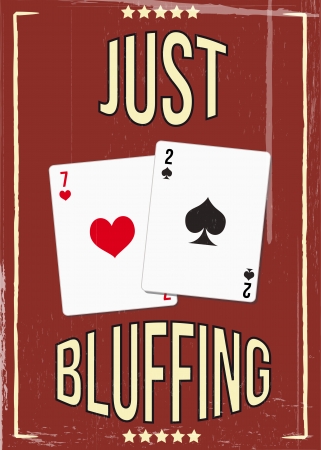

But, the best bluffers are those who also use the Esther Bluff tactic (discussed in detail in my aforementioned book, The Art of Bluffing). The Esther Bluff is a series of actions and mannerisms – without uttering a word – that serve to embed your desired message into your opponent’s brain, convincing them that you hold a big hand – so he/she folds, leaving the pot to you. It also applies when you try to steal the pot in the early stages of the hand (there is a scientific basis for this tactic).
Other important bluffing skills include, but are not limited to:
And, as always, position is important. We will discuss this and other aspects of successful bluffing in our next column…